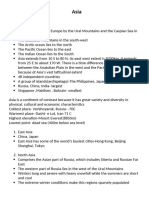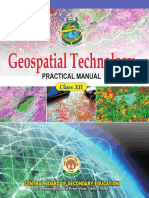0 ratings0% found this document useful (0 votes)
691 viewsAsia Physical Geography PW
Asia Physical Geography PW
Uploaded by
Dan GregoriousSouth Asia is defined by the Himalayan mountain range and three major river systems - the Indus, Brahmaputra, and Ganges. These physical features have shaped the region's dense population in the Indo-Gangetic plain and monsoon climate. East Asia contains mountain ranges that isolated China, as well as deserts and plateaus in western China. Major rivers include the Yellow and Yangtze. Southeast Asia consists of mainland and island regions, with volcanic mountains and archipelagos plagued by monsoons and vulnerable to tsunamis caused by tectonic activity.
Copyright:
© All Rights Reserved
Available Formats
Download as PPT, PDF, TXT or read online from Scribd
Asia Physical Geography PW
Asia Physical Geography PW
Uploaded by
Dan Gregorious0 ratings0% found this document useful (0 votes)
691 views25 pagesSouth Asia is defined by the Himalayan mountain range and three major river systems - the Indus, Brahmaputra, and Ganges. These physical features have shaped the region's dense population in the Indo-Gangetic plain and monsoon climate. East Asia contains mountain ranges that isolated China, as well as deserts and plateaus in western China. Major rivers include the Yellow and Yangtze. Southeast Asia consists of mainland and island regions, with volcanic mountains and archipelagos plagued by monsoons and vulnerable to tsunamis caused by tectonic activity.
Original Title
asia-physical-geography-pw.ppt
Copyright
© © All Rights Reserved
Available Formats
PPT, PDF, TXT or read online from Scribd
Share this document
Did you find this document useful?
Is this content inappropriate?
South Asia is defined by the Himalayan mountain range and three major river systems - the Indus, Brahmaputra, and Ganges. These physical features have shaped the region's dense population in the Indo-Gangetic plain and monsoon climate. East Asia contains mountain ranges that isolated China, as well as deserts and plateaus in western China. Major rivers include the Yellow and Yangtze. Southeast Asia consists of mainland and island regions, with volcanic mountains and archipelagos plagued by monsoons and vulnerable to tsunamis caused by tectonic activity.
Copyright:
© All Rights Reserved
Available Formats
Download as PPT, PDF, TXT or read online from Scribd
Download as ppt, pdf, or txt
0 ratings0% found this document useful (0 votes)
691 views25 pagesAsia Physical Geography PW
Asia Physical Geography PW
Uploaded by
Dan GregoriousSouth Asia is defined by the Himalayan mountain range and three major river systems - the Indus, Brahmaputra, and Ganges. These physical features have shaped the region's dense population in the Indo-Gangetic plain and monsoon climate. East Asia contains mountain ranges that isolated China, as well as deserts and plateaus in western China. Major rivers include the Yellow and Yangtze. Southeast Asia consists of mainland and island regions, with volcanic mountains and archipelagos plagued by monsoons and vulnerable to tsunamis caused by tectonic activity.
Copyright:
© All Rights Reserved
Available Formats
Download as PPT, PDF, TXT or read online from Scribd
Download as ppt, pdf, or txt
You are on page 1of 25
At a glance
Powered by AI
The passage discusses the major physical geography of Asia, focusing on South, Southeast, and East Asia. It describes the location and impact of key physical features like mountains, rivers, climate patterns, and islands in dividing and shaping the regions.
Asia is divided into South Asia, Southeast Asia, and East Asia by major mountain ranges like the Himalayas. South Asia is referred to as the Indian subcontinent. East Asia includes countries like China, Japan, and the Koreas while Southeast Asia consists of mainland and island countries.
The Himalayas and Hindu Kush mountains have kept central Asian tribes from invading India. The Indus, Ganges, and Brahmaputra rivers originate in the Himalayas and support life across South Asia, with the Ganges being sacred to Hindus. The rivers and Indo-Gangetic plain are where most of India's population lives.
Asia: Physical Geography
SSWG5 The student will describe the interaction of
physical and human systems that have shaped
contemporary South Asia, Southeastern Asia, and
Eastern Asia.
a. Describe the location of major physical features and
their impact on the regions of Asia.
Dividing the Region
South Asia (Indian Peninsula)
– India, Pakistan, Bangladesh, etc.
East Asia
– China, Taiwan, Japan, North and South
Korea
Southeast Asia
– Vietnam, Thailand, Indonesia, Malaysia, etc.
South Asia
Subcontinent-South Asia is separated
from the rest of Asia by mountain
ranges-like a continent, only smaller
Surrounded by 3 bodies of water-
Arabia Sea, Indian Ocean and the Bay
of Bengal
75% of the landmass in the country of
India
South Asia: Mountains
The Himalayas
– Formed 60 million years ago-1,500 miles
long
– Mount Everest-world’s highest peak-29,028
feet high
– Rooftop of the world
Hindu Kush
– Kept central Asian tribes from invading
India
South Asia: Rivers
3 great river systems begin in the
Himalayas
– Indus-flows mostly through Pakistan and
empties into the Arabia Sea
– Brahmaputra and Ganges-flow east into the
Bay of Bengal
Rivers support life in the region
Ganges River is sacred for Hindus
The Indo-Gangetic Plain is the most
heavily populated part of South Asia
– 3/5 of India’s population
Home to the world’s 14 highest peaks including Mount
Everest!!
South Asia: Climate
Half of the world’s climate zones are found in
South Asia
Monsoons
– October-February, dry winds blow across South
Asia from the northeast
– June-September, the winds blow in from the
southwest bringing moist ocean air and heavy
rainfall
Monsoons are both devastating and beneficial
to life in South Asia
East Asia: Mountains, Plateaus, &
Deserts
Mountains kept China isolated from
other parts of Asia
– Himalayas, Altai and Kunlun Mountains
Plateaus, basins and deserts in western
China make the area sparsely populated
Gobi Desert
– One of the largest in the world
– Larger than Texas and California combined
East Asia
Major Rivers of China
– Huang He (Yellow River)
Called the Yellow River because of its yellow silt
Also called “china’s sorrow” because of the
terrible floods it has caused
– Chang Jiang (Yangtze River)
Longest river in all of Asia
Serves as a major trade route
Also floods causing a lot of damage
East Asia
Islands and Peninsulas:
Korean Peninsula contains the countries
of North and South Korea
Japan is an island nation on an
archipelago
– Many volcanoes and experiences
earthquakes
Southeast Asia
Southeast Asia consists of 2 parts:
– Mainland: Indochinese and Malay Peninsulas
– Islands (archipelagos)
Many of Southeast Asia’s mountains are
of volcanic origin.
– Part of the Ring of Fire
The region is also plagued by monsoons
Archipelagoes
Indonesia: 13,000 Philippines: 7,100
islands islands
Tsunamis
Nations in East Asia and Southeast Asia
experience the effects of tsunamis
Earthquakes and other tectonic
movement can cause huge waves called
tsunami
Tsunami waves can travel at hundreds
of miles an hour and rise up to 100 feet
or more in height
You might also like
- IGCSE Geography Skills BookletDocument80 pagesIGCSE Geography Skills Bookletnio7851100% (5)
- Humanistic Geography With NotesDocument20 pagesHumanistic Geography With NotesSean Sheehe100% (1)
- GMAT1110 SummaryDocument13 pagesGMAT1110 SummaryBenjamin BrownNo ratings yet
- Unified Field TheoryDocument10 pagesUnified Field TheoryApurva RaiNo ratings yet
- Syllabus JKPSC Lecturer 10 + 2 GeographyDocument3 pagesSyllabus JKPSC Lecturer 10 + 2 GeographybhatttshafqatNo ratings yet
- INTERVISBILITYDocument3 pagesINTERVISBILITYAmaliaNo ratings yet
- Class 11 Geography MCQDocument6 pagesClass 11 Geography MCQJunaid AkhtarNo ratings yet
- Formate - Hum - Quality of Life - QOL - in Urban Slums A Geographical Appraisal From Purulia Municipality, West Bengal, IndiaDocument12 pagesFormate - Hum - Quality of Life - QOL - in Urban Slums A Geographical Appraisal From Purulia Municipality, West Bengal, IndiaImpact JournalsNo ratings yet
- Resources & DevelopmentDocument10 pagesResources & Developmentdhdahanuwala100% (1)
- University of Karachi: (Mauryan Economy)Document5 pagesUniversity of Karachi: (Mauryan Economy)Syed Mohsin Mehdi TaqviNo ratings yet
- Elements of Environmental Studies: November 2018Document13 pagesElements of Environmental Studies: November 2018Sponge BobNo ratings yet
- Concept of Rural GeographyDocument4 pagesConcept of Rural Geographytabita1303100% (2)
- DDP Desert Development ProgrammeDocument14 pagesDDP Desert Development ProgrammeajeethowNo ratings yet
- UNO HistoryDocument4 pagesUNO HistoryAbdul SattarNo ratings yet
- #Indian Economy - Unit IIDocument64 pages#Indian Economy - Unit IIAashish MehraNo ratings yet
- Bansal (Definition and Scope of Urban Geo) PDFDocument10 pagesBansal (Definition and Scope of Urban Geo) PDFOwen NaldozaNo ratings yet
- Assumptions of Von Thunen Model of Agricultural Land Use TheoryDocument3 pagesAssumptions of Von Thunen Model of Agricultural Land Use TheoryKrisha RozNo ratings yet
- The Five Themes in GeographyDocument7 pagesThe Five Themes in GeographyAlbert Grefal MatandagNo ratings yet
- Towards Post Modernism: Geography in The 21 ST Century, Future of GeographyDocument10 pagesTowards Post Modernism: Geography in The 21 ST Century, Future of GeographyRohamat MandalNo ratings yet
- Physical Geography NotesDocument2 pagesPhysical Geography Noteschuchaylopez7No ratings yet
- Spatial Interaction Concept of Ullman and Graviy ModelDocument6 pagesSpatial Interaction Concept of Ullman and Graviy ModelSandeep BishnoiNo ratings yet
- Weaver Crop Combination MethodDocument6 pagesWeaver Crop Combination MethodmallikaNo ratings yet
- Notes On Frontiers and BoundariesDocument3 pagesNotes On Frontiers and Boundariesgaurav3145No ratings yet
- 8 SSCDocument10 pages8 SSCRashmi Prabhakar100% (1)
- SOILS Profile and CatenaDocument9 pagesSOILS Profile and CatenaErick Juma Wabwile50% (2)
- Source of Energy Class 10 What Is A Good Source of Energy?: Fossil FuelsDocument7 pagesSource of Energy Class 10 What Is A Good Source of Energy?: Fossil FuelsPrem RajNo ratings yet
- India USA RelationDocument11 pagesIndia USA RelationShubham MeghwalNo ratings yet
- Soil GeographyDocument22 pagesSoil GeographyCBSE UGC NET EXAMNo ratings yet
- Density & Distribution of Population in BangladeshDocument13 pagesDensity & Distribution of Population in BangladeshMizanur RahmanNo ratings yet
- Fluvial LandformsDocument12 pagesFluvial LandformsSarveshVishnarNo ratings yet
- Economic Activities Concept and ClassificationDocument12 pagesEconomic Activities Concept and ClassificationKamran Khan100% (1)
- Branches of GeographyDocument7 pagesBranches of GeographyBohar singh Brar BrarNo ratings yet
- Introduction To GeographyDocument26 pagesIntroduction To GeographyHassan razaNo ratings yet
- North East India PotentialDocument1 pageNorth East India PotentialOO7 FactsNo ratings yet
- The Function and Methods of Electoral GeographyDocument9 pagesThe Function and Methods of Electoral GeographyM. Aulia rahmanNo ratings yet
- Lec#1 Summar 11Document36 pagesLec#1 Summar 11Asif Imran100% (1)
- Nature and Scope of Human Geography: StructureDocument14 pagesNature and Scope of Human Geography: StructureSharan OttiNo ratings yet
- Natural ResourcesDocument33 pagesNatural Resourcesprashant_katti_1No ratings yet
- 5 Themes of Geography 2021Document31 pages5 Themes of Geography 2021drinkwaltertrentNo ratings yet
- Managerial Economics MANB403: Prof. Tanuja DubeyDocument51 pagesManagerial Economics MANB403: Prof. Tanuja DubeyTushar100% (1)
- Chapter 1 Review QuizDocument6 pagesChapter 1 Review QuizFeng DuNo ratings yet
- Geo-Major Cultural Realms of The WorldDocument7 pagesGeo-Major Cultural Realms of The WorldYatendra SinghNo ratings yet
- City Regions in IndiaDocument4 pagesCity Regions in IndiaPooja JariwalaNo ratings yet
- Management of Natural Resources - Question Bank PDFDocument7 pagesManagement of Natural Resources - Question Bank PDFRatheesh Hrishikesh100% (1)
- The Modern Concept of GeographyDocument16 pagesThe Modern Concept of GeographyMd Naimur Rahman KhanNo ratings yet
- Approaches To UrbanizationDocument10 pagesApproaches To UrbanizationWasafAliAzmatNo ratings yet
- Determinism and Possibilism - Partha DasDocument9 pagesDeterminism and Possibilism - Partha Daspartha dasNo ratings yet
- Population Resource Regions-1Document16 pagesPopulation Resource Regions-1Zubair AnsariNo ratings yet
- Urban Rural Equity IssueDocument3 pagesUrban Rural Equity IssueShekinah Puntilar100% (1)
- Geometry of Aerial PhotographsDocument30 pagesGeometry of Aerial PhotographsHedaeturRahmanNo ratings yet
- Examples of Differentiated Lesson Plans - Rise of Hitler and The Aggression of Nazi GermanyDocument17 pagesExamples of Differentiated Lesson Plans - Rise of Hitler and The Aggression of Nazi GermanyNatalia Busnadiego BarbozaNo ratings yet
- Population NotesDocument38 pagesPopulation NotesSohail GamiNo ratings yet
- Post Classical GermanDocument5 pagesPost Classical GermanVirendra PratapNo ratings yet
- Lesson 1-Concept of Asia and Physical GeographyDocument25 pagesLesson 1-Concept of Asia and Physical GeographyRD SuarezNo ratings yet
- ICSE - Geog - India Location, Extent, Political - 1Document13 pagesICSE - Geog - India Location, Extent, Political - 1Tara bhai JoginderNo ratings yet
- Non Physical Factors of AgricultureDocument60 pagesNon Physical Factors of AgricultureDevyani HadaNo ratings yet
- Introduction To Economic GeographyDocument55 pagesIntroduction To Economic GeographyTAZWARUL ISLAM100% (1)
- 6.population Notes-9th GeographyDocument7 pages6.population Notes-9th GeographyadvsureshnshindeNo ratings yet
- ConurbationDocument6 pagesConurbationanju sureshNo ratings yet
- Forest and Wildlife ResourcesDocument6 pagesForest and Wildlife ResourcesSiddharth R 9DNo ratings yet
- Regional Planning in India A Target Area and Target Group Approach by Tulika SanadhyaDocument17 pagesRegional Planning in India A Target Area and Target Group Approach by Tulika SanadhyaDr. SHIVA AITHAL86% (7)
- Asia 1Document5 pagesAsia 1bhuvirathi10No ratings yet
- Computer Laboratory GuidelinesDocument1 pageComputer Laboratory GuidelinesDan GregoriousNo ratings yet
- Week 10. Transforming School CultureDocument26 pagesWeek 10. Transforming School CultureDan GregoriousNo ratings yet
- 4P's Gregorious Page Research CongressDocument10 pages4P's Gregorious Page Research CongressDan GregoriousNo ratings yet
- Beverly Kate Tomagan Final-Assessment 2021-01-22 F9yiiDocument29 pagesBeverly Kate Tomagan Final-Assessment 2021-01-22 F9yiiDan GregoriousNo ratings yet
- Circular Flow Diagram: Resources Factors of Production Goods & ServicesDocument2 pagesCircular Flow Diagram: Resources Factors of Production Goods & ServicesDan GregoriousNo ratings yet
- Dan Lhery S. Gregorious MidtermDocument3 pagesDan Lhery S. Gregorious MidtermDan GregoriousNo ratings yet
- Researc H Title: Lesson 4Document10 pagesResearc H Title: Lesson 4Dan GregoriousNo ratings yet
- 1355 Di Ko Alam EhDocument4 pages1355 Di Ko Alam EhDan GregoriousNo ratings yet
- L.E.T. Social Dimension of EducationDocument69 pagesL.E.T. Social Dimension of EducationDan GregoriousNo ratings yet
- Private Files UNESCO Four Pillars of EducationDocument13 pagesPrivate Files UNESCO Four Pillars of EducationDan GregoriousNo ratings yet
- PracRes2 Module 1 Lesson 2Document16 pagesPracRes2 Module 1 Lesson 2Dan GregoriousNo ratings yet
- Flood Vulnerability Assessment of The Upper Cross River Basin Using Morphometric Analysis2020geomatics Natural Hazards and RiskOpen AccessDocument27 pagesFlood Vulnerability Assessment of The Upper Cross River Basin Using Morphometric Analysis2020geomatics Natural Hazards and RiskOpen AccessMauro AndradeNo ratings yet
- Map 3 - ChoroplethDocument1 pageMap 3 - Choroplethapi-352028176No ratings yet
- Role Principal Investigator: Component-I (A) - Personal Details Name Affiliation Prof. Masood Ahsan SiddiquiDocument12 pagesRole Principal Investigator: Component-I (A) - Personal Details Name Affiliation Prof. Masood Ahsan SiddiquiRishu RajNo ratings yet
- Oruxmapsdesktop enDocument6 pagesOruxmapsdesktop enDeadsenseiNo ratings yet
- Diss 1stq ExamDocument7 pagesDiss 1stq ExamELSIE VALLEDORNo ratings yet
- Geography Coursework Epping ForestDocument4 pagesGeography Coursework Epping Forestf634dexc100% (1)
- Sight Reduction Tables - Pub 229 Vol 1Document397 pagesSight Reduction Tables - Pub 229 Vol 1Daniel Brumbaugh Sr.No ratings yet
- Direction: Course Title: Geography 1 (Basic Geography)Document7 pagesDirection: Course Title: Geography 1 (Basic Geography)jiggly popNo ratings yet
- Popejoy Dissertation PrizeDocument8 pagesPopejoy Dissertation PrizeBuyingCollegePapersCanada100% (1)
- Estudios Urbanisticos Literatura HispanoamericanaDocument223 pagesEstudios Urbanisticos Literatura HispanoamericanaCésar Andrés ParedesNo ratings yet
- Asia Map and Satellite ImageDocument1 pageAsia Map and Satellite ImageShadid AhnafNo ratings yet
- Three Year Degree CourseDocument6 pagesThree Year Degree CourseSubreng BasumataryNo ratings yet
- EcdisDocument2 pagesEcdisAlexanderZalevskiyNo ratings yet
- ReferencesDocument2 pagesReferencesandryzsafetyNo ratings yet
- Reeds TidesDocument10 pagesReeds TidesFlyARP100% (1)
- The Future of GeographyDocument9 pagesThe Future of GeographyantonyjustinofogacaNo ratings yet
- Coordinate Systems in Geodesy: E. J. Krakiwsky D. E. WellsDocument126 pagesCoordinate Systems in Geodesy: E. J. Krakiwsky D. E. WellsmmNo ratings yet
- Mapping The World: Justin, Tatian, Lucian, and The Second SophisticDocument33 pagesMapping The World: Justin, Tatian, Lucian, and The Second SophisticdesoeuvreNo ratings yet
- Ngang Grin Hkra Gawde Da Sai Amyu Sha Shanglawt Rawt Malan Lam Hpe Ngang Kang Hkra Hkrang Shale Shanglawm Na LamDocument5 pagesNgang Grin Hkra Gawde Da Sai Amyu Sha Shanglawt Rawt Malan Lam Hpe Ngang Kang Hkra Hkrang Shale Shanglawm Na LamHG KachinNo ratings yet
- GpsDocument1 pageGpsnudangiNo ratings yet
- Pedosphere - Bits For The Answers To The Questions of The Worksheet + Page 2 To Fill in RANDOMDocument2 pagesPedosphere - Bits For The Answers To The Questions of The Worksheet + Page 2 To Fill in RANDOMoravkinovasara1No ratings yet
- Sudarshangurjar Com Indian Geographical Extent and FrontiersDocument12 pagesSudarshangurjar Com Indian Geographical Extent and Frontiersakash TiwariNo ratings yet
- Geo 111 Hist & Phil IntroductionDocument10 pagesGeo 111 Hist & Phil Introductiontonnyjoseph807No ratings yet
- 818-Geospatial Technology (PM) - XII PDFDocument98 pages818-Geospatial Technology (PM) - XII PDFYour DadNo ratings yet
- Journal of Geographical Research - Vol.6, Iss.2 April 2023Document73 pagesJournal of Geographical Research - Vol.6, Iss.2 April 2023Bilingual PublishingNo ratings yet
- 4.2.gs-Marpol Special AreasDocument13 pages4.2.gs-Marpol Special AreasCosminNo ratings yet
- By: Tarun Maurya ROLL NO: 13129 Branch: CedDocument10 pagesBy: Tarun Maurya ROLL NO: 13129 Branch: CedTarun MauryaNo ratings yet
- Dao 1998-12-2Document91 pagesDao 1998-12-2JULIUS MIRALONo ratings yet




































































































